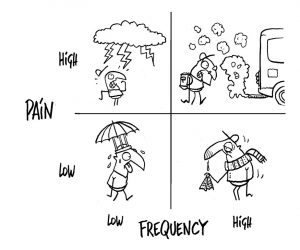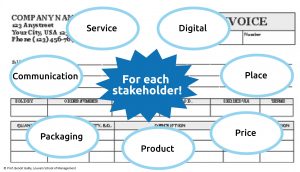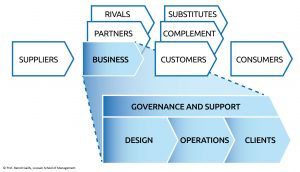 The first (obvious but still too often forgotten) strategic challenge of a successful business model is to address somebody’s problem. It must demonstrate that potentially enough people out there have a problem and that the problem is painful enough for them to be ready to both adopt and pay for a new solution.
The first (obvious but still too often forgotten) strategic challenge of a successful business model is to address somebody’s problem. It must demonstrate that potentially enough people out there have a problem and that the problem is painful enough for them to be ready to both adopt and pay for a new solution.
 The second strategic challenge of a successful business model is to be better positioned than others. The innovators and their organization must demonstrate that they could address a relevant problem or meet a need better than the available alternatives, based on their scope as well as their scale, unique assets and/or agility.
The second strategic challenge of a successful business model is to be better positioned than others. The innovators and their organization must demonstrate that they could address a relevant problem or meet a need better than the available alternatives, based on their scope as well as their scale, unique assets and/or agility.
 On the other hand, the first operational challenge of a successful business model is to conceive an initial value proposition, which some people will actually be ready and able to find, adopt and pay for. What will be on the first invoice?
On the other hand, the first operational challenge of a successful business model is to conceive an initial value proposition, which some people will actually be ready and able to find, adopt and pay for. What will be on the first invoice?
 The second – and too often forgotten – operational challenge of a successful business model is to set up, integrate and scale up over time a competitive and sustainable value chain, including the right design, operations, client management and support activities.
The second – and too often forgotten – operational challenge of a successful business model is to set up, integrate and scale up over time a competitive and sustainable value chain, including the right design, operations, client management and support activities.
Bibliography
Strategy: Why? Addressing somebody’s problem
Keywords: empathic design, market analysis, segmentation, target market
- (Book) Christensen, C.M. and Raynor, M.E. (2003) The Innovator’s solution, Harvard Business School Press
- (Book) Maslow, A.H. (1998) Towards a Psychology of Being, 3rd ed., Wiley
- (Video) Jobs-to-Be-Done by Prof. Clayton Christensen
- (Video) Anthony Ulwick (2016) What Customers Want: Using Outcome-Driven Innovation to Create Breakthrough Products and Services;
- (Article) Acemoglu, D., & Linn, J. (2004). Market size in innovation: theory and evidence from the pharmaceutical industry. The Quarterly Journal of Economics, 119(3), 1049-1090.
- (Article) Covin, J. G., Garrett, R. P., Kuratko, D. F., & Shepherd, D. A. (2015). Value proposition evolution and the performance of internal corporate ventures. Journal of Business Venturing, 30(5), 749-774.
- (Article) Christensen, C. M., Hall, T., Dillon, K., & Duncan, D. S. (2016). Know your customers’“jobs to be done”. Harvard Business Review, 94(9), 54-62.
- (Article) Dubois, P., De Mouzon, O., Scott‐Morton, F., & Seabright, P. (2015). Market size and pharmaceutical innovation. The RAND Journal of Economics, 46(4), 844-871.
- (Article) Griffin, A., & Hauser, J. R. (1993). The voice of the customer. Marketing Science, 12(1), 1-27.
- (Article) Leonard, D., & Rayport, J. (1997). ‘Spark innovation through empathic design’,
Harvard Business Review, 75(6), 102-113. - (Article) Liedtka, J. (2015). Perspective: Linking design thinking with innovation outcomes through cognitive bias reduction. Journal of Product Innovation Management, 32(6), 925-938.
- (Article) O’Connor, G. C., & Veryzer, R. W. (2001). The nature of market visioning for technology‐based radical innovation. Journal of Product Innovation Management, 18(4), 231-246.
- (Article) Reid, S. E., & De Brentani, U. (2010). Market vision and market visioning competence: Impact on early performance for radically new, high‐tech products. Journal of Product Innovation Management, 27(4), 500-518.
- (Article) Slater, S. F., & Mohr, J. J. (2006). Successful development and commercialization of technological innovation: insights based on strategy type. Journal of Product Innovation Management, 23(1), 26-33.
Strategy: Why us? Being better positioned than others
Keywords: competitiveness, strategic fit, technology regimes, unique assets
- (Book) Brown, Shona L., and Kathleen M. Eisenhardt. Competing on the edge: Strategy as structured chaos. Harvard Business Press, 1998.
- (Book) Porter, Michael E. “Competitive advantage: creating and sustaining superior performance. 1985.” New York: FreePress (1985).
- (Video) The End of Competitive Advantage, Harvard Business Review
- (Article) Adner, R., & Zemsky, P. (2006). A demand‐based perspective on sustainable competitive advantage. Strategic Management Journal, 27(3), 215-239.
- (Article) Agrawal, V.V., Atasu, A., & Van Ittersum, K. (2015). Remanufacturing, third-party competition, and consumers’ perceived value of new products. Management Science, 61(1), 60-72.
- (Article) Ahuja, G., Lampert, C.M., & Novelli, E. (2013). The second face of appropriability: Generative appropriability and its determinants. Academy of Management Review, 38(2), 248-269.
- (Article) Casadesus‐Masanell, R., & Zhu, F. (2013). Business model innovation and competitive imitation: The case of sponsor‐based business models. Strategic Management Journal, 34(4), 464-482.
- (Article) Christensen, C. M. (2001). The past and future of competitive advantage. MIT Sloan Management Review, 42(2), 105-109.
- (Article) Cooper, R. G. (1979). The dimensions of industrial new product success and failure. Journal of Marketing, 43(3), 93-103.
- (Article) Cooper, R. G., & Kleinschmidt, E. J. (1987). New products: what separates winners from losers?. Journal of Product Innovation Management, 4(3), 169-184.
- (Article) Dierickx, I., & Cool, K. (1989). Asset stock accumulation and sustainability of competitive advantage. Management Science, 35(12), 1504-1511.
- (Article) Haynie, J.M., Shepherd, D.A., & McMullen, J.S. (2009). An Opportunity for Me? The Role of Resources in Opportunity Evaluation Decisions. Journal of Management Studies, 46(3), 337-361.
- (Article) Kulins, C., Leonardy, H., & Weber, C. (2016). A configurational approach in business model design. Journal of Business Research, 69(4), 1437-1441.
- (Article) Leiponen, A., & Byma, J. (2009). If you cannot block, you better run: Small firms, cooperative innovation, and appropriation strategies. Research Policy, 38(9), 1478-1488.
- (Article) Lepak, D. P., Smith, K. G., & Taylor, M. S. (2007). Value creation and value capture: A multilevel perspective. Academy of Management Review, 32(1), 180-194.
- (Article) McGrath, R. G. (2013). Transient advantage. Harvard Business Review, 91(6), 62-70.
- (Article) McKnight, B. & Zietsma, C. (2018). Finding the threshold: A configurational approach to optimal distinctiveness, Journal of Business Venturing, 33(4), 493-512,
- (Article) Mitchell, D., & Coles, C. (2003). The ultimate competitive advantage of continuing business model innovation. Journal of Business Strategy, 24(5), 15-21.
- (Article) Nag, R., Hambrick, D. C., & Chen, M. J. (2007). What is strategic management, really? Inductive derivation of a consensus definition of the field. Strategic Management Journal, 28(9), 935-955.
- (Article) Shepherd, D. A. (1999). Venture capitalists’ assessment of new venture survival. Management Science, 45(5), 621-632.
- (Article) Spieth, P., Schneckenberg, D., & Matzler, K. (2016). Exploring the linkage between business model (&) innovation and the strategy of the firm. R&D Management, 46(3), 403-413
- (Article) Thornhill, S., & Amit, R. (2001). A dynamic perspective of internal fit in corporate venturing. Journal of Business Venturing, 16(1), 25-50.
Operations: What could be sold? Designing the value proposition
Keywords: industrial design, product/market positioning, prototypes, value proposition
- (Book) Kotler Ph. « Marketing Management »; Prentice Hall
- (Video) Rory Sutherland: Life lessons from an ad man – TED talk
- (Video) Clayton Christensen – When only a milkshake will do the job
- (Article) Baden-Fuller, C., & Haefliger, S. (2013). Business models and technological innovation. Long Range Planning, 46(6), 419-426.
- (Article) Gans, J., Scott, E. L., & Stern, S. (2018). Strategy for Start-ups. Harvard Business Review, 96(3), 44-51.
- (Article) Gans, J. S., & Stern, S. (2003). The product market and the market for “ideas”: commercialization strategies for technology entrepreneurs. Research Policy, 32(2), 333-350.
- (Article) Gemser, G., & Leenders, M. A. (2001). How integrating industrial design in the product development process impacts on company performance. Journal of Product Innovation Management, 18(1), 28-38.
- (Article) Martin, R. L. (2011). The innovation catalysts. Harvard Business Review, 89(6), 82-87.
- (Article) Hauser, J., Tellis, G J., & Griffin, A. (2006). Research on innovation: A review and agenda for marketing science. Marketing Science, 25(6), 687-717.
- (Article) Johnson, M.W., Christensen, C.M., & Kagermann, H. (2008). Reinventing your business model. Harvard Business Review, 86(12), 57-68.
- (Article) Manu, Franklyn A., and Ven Sriram. (1996) “Innovation, marketing strategy, environment, and performance.” Journal of Business Research 35(1), 79-91.
- (Article) Matthyssens, P., & Vandenbempt, K. (2008). Moving from basic offerings to value-added solutions: Strategies, barriers and alignment. Industrial Marketing Management, 37(3), 316-328.
- (Article) Ulaga, W., & Reinartz, W. J. (2011). Hybrid offerings: how manufacturing firms combine goods and services successfully. Journal of Marketing, 75(6), 5-23.
- (Article) Weerawardena, Jay. “The role of marketing capability in innovation-based competitive strategy.” Journal of strategic marketing 11.1 (2003): 15-35.
Operations: What could be done? Assembling a competitive value chain
Keywords: client management, operations, sales & marketing, support, value chain design
- (Book) Porter, M.E. (1985) Competitive Advantage, The Free Press, New York
- (Video) Value Chain Innovations in Business Eco-Systems; Stanford Online
- (Article) Jacobides, M.G., Knudsen, T., & Augier, M. (2006). Benefiting from innovation: Value creation, value appropriation and the role of industry architectures. Research Policy, 35(8), 1200-1221.
- (Article) Jacobides, Michael G., and Sidney G. Winter. “The co‐evolution of capabilities and transaction costs: Explaining the institutional structure of production.” Strategic Management Journal 26.5 (2005): 395-413.
- (Article) Jacobides, M. G., & Winter, S. G. (2005). The co‐evolution of capabilities and transaction costs: Explaining the institutional structure of production. Strategic Management Journal, 26(5), 395-413..
- (Article) Tee, R., & Gawer, A. (2009). Industry architecture as a determinant of successful platform strategies: A case study of the i‐mode mobile Internet service. European Management Review, 6(4), 217-232.
- (Article) Porter, M., & Siggelkow, N. (2008). Contextuality within activity systems and sustainability of competitive advantage. The Academy of Management Perspectives, 22(2), 34-56.
(c) Prof. Benoit Gailly, Louvain School of Management


